Introduction
Grapes belonging to Family Vitaceaeare commercially important fruit crop of India. It is a temperate crop which has got adapted to sub-tropical climate of peninsular India. India is among the first ten countries in the world in the production of grape. This crop occupies fifth position amongst fruit crops in India with a production of 1.21 million tones (around 2% of world’s production of 57.40 million tons).
Grapes are highly perishable non climacteric fruits with reduced shelf-life due to decay, weight loss, and nutrient degradation during the storage time. Grapes can be decay during pre-harvest and post-harvest and post-harvest decay of grapes can be due to physical, physiological, or pathological factors. Rach is dehydration is a main decay factor (physical deterioration) of grapes during the pre or post harvest.23,24 Skin browning of grapes is another main physiological problem associated with mature table grape cultivar.79
Major cause for grape spoilage is fungal infection, which decreases the production of fruit.75 Fungicides spray prevent decay of grapes but because of health hazard effects with the application of fungicides, have become restrictive, there is a necessity of natural substitutes, such as the application of essential oils of plants which shows higher effectiveness in preventing decay of table grapes.79,52
Aloe verahas medicinal properties, is a tropical and subtropical plant that has been used from ancient time.29 The gel of Aloe vera leaves is the colorless mucilaginous, obtained from the parenchymatous cells. The usage of Aloe veragel in the food industry is increasing day by day as resource of drinks, beverages and ice creams.29 Aloe verais a stem less and very short-stemmed succulent plant belongs to family Liliaceae.74,53 The medical uses of the gel juice (orally) are against skin diseases, constipation, radiation injury gastrointestinal, kidney and cardiovascular problems; reduce the cholesterol and triglyceride levels in blood. Recently other important property of Aloe verahas been reported such as anti-inflammatory and antibiotic activities against some diseases like diabetics, cancer, allergy and AIDS28,60. Aloe veragel is also used in the cosmetic industry, including treatment of burns and scars and in wound healing.1 The antifungal activity of aloe veragel has observed against several pathogenic fungi including Botrytis cinerea, main causative agent to decay grape fruit.42,63
Edible coatings create a modified atmosphere around the fruit by providing a semi permeable barrier to water vapour and gases, and their use offers an attractive alternative to film packaging due to their environmentally friendly characteristic. They have been used since ancient time to protect perishable food stuffs from deterioration by retarding dehydration, suppressing respiration, improving textural quality to retain volatile flavor compounds, and reducing microbial growth.25,54
Due to increased consumer’s demand for food without chemical preservatives has resulted in application of natural antimicrobials preservatives and antimicrobial films and fungicide application can be reduced. To avoid fruit spoilage it is essential to preserve fruits and it has been estimated that around 25 to 80 per cent of harvested fresh fruits are wasted due to spoilage.58
Aloe vera gel is a novel edible coating for organic fruit storage technology. Application of aloe vera gel coating has been reported to extend shelf life by delaying post-harvest loss of quality in fruits and vegetables. There are natural preservatives which are used as edible surface coatings for vegetables and fruits such as waxes but these coatings commonly contain ingredients such as polyethylene, carnauba and candelilla.39,25,3 Amarante et al., (2001); Jeonget al., (2003) have studied wax coating as fruits preservatives and increase the shelf life, slows down ripening, retards water loss, reduces decay and enhances visual quality.
The Aloe gel is composed of water, amino acids, vitamins, lipids, sterols, tannins, and enzymes64 and contains phenol, saponin, anthraquinones components, have anti-bacterial, antiviral and antifungal properties. Aloe vera has shown antibacterial property against gram positive and gram negative pathogens.2 Aspergillus, Fusarium and Penicilliumare fungal species which are responsible for oxidation and spoilage of food (A. Babaei et al., 2013). Aloe veracan be applied as edible coatings for fruits as its biological activities prevent loss of moisture, firmness, control respiration rate and maturation development, delay oxidative browning, and reduce microorganism proliferation.79,52
Materials and Methods
The present study was conducted in the Department of Post-harvest Process and Food Engineering. The pictures of different equipment are shown in figures 3.1, 3.2, 3.3, 3.4, 3.5. Chlorine for pre-treatment and cleaning of grapes was taken from the chemical store. A BOD automatic incubator and a refrigerator were used for storage of grapes after coating. The temperature range of incubator is 5⁰ Cto 50⁰ Cand sensitivity ranges up to 0.5⁰C. Temperature range of refrigerator was 4⁰C to 18⁰C. A magnetic stirrer was used to mix thoroughly mix the Aloe vera with water. Digital Pocket pH test meter was used for estimation of pH.
Plant Material
Fresh healthy Indian Grapes “Thompson Seedless‟ green colour grapes were purchased from the Main Market, Pantnagar, Uttarakhand.
Surface Preparation of Grapes
The primary purpose of surface preparation was to remove all the contaminants that would hinder proper coating adhesion and to render a sound, clean substrate, suitable for firm bonding. The grapes were washed with chlorine for blanching.
Preparation of Aloe vera coating
The Aloe vera was purchased from the Main Market, Pantnagar, manufactured by PatanjaliAyurved Ltd. The Aloe vera was heated at 70⁰C and then was immediately cooled for stabilization and ascorbic acid (1.9-2.0g, L-1) and citric acid (4.5-4.6g, L-1) was added to maintain the pH at 4. The solution was stored in darkness to to prevent oxidation of solution.2
Coating Application
After washing the grapes were air dried and divided in to 16 groups (100gm ±1gm), which corresponded to 4 coating treatments (0% control), 10%, 20%, 30% then grapes were dipped in to the gel for 5 minutes and were then air dried for 30 minutes. Eight groups were stored in refrigerator at 4⁰C in which 4 groups were poly packed and 4 groups were stored in open plates. Remaining 8 groups were stored in incubator at 30⁰C and 4 groups were poly packed and 4 were stored in open plates. Physiciological parameters were carried out weekly in triplicates.
Grape quality assessment
Groups of each treatment were visually examined for the rachis appearance, incidence of cracked and shattered berries, decay, browning, and assessed acceptability by a panel of 5 persons. The visual characteristics were scored in daylight. So the quality of grapes was assessed at the end of storage by evaluation of berry, incidence of cracked, brown, and shatters berries, berry color and weight loss.
pH assessment
Fruit juice was obtained by extraction of berries and filtered through cheesecloth for the measurement of pH.pH was measured by digital pocket pH meter. The readings were taken in triplicate basis on the first day and after the different sampling dates.
Weight Loss Assessment
Weights of individual groups were recorded on the first day and after the different sampling dates. Weight losses were expressed by the following relationship:
Weight loss(g/100g)={(Wₒ‒Wf )/Wₒ} X 100
Where
Wₒ – initial weight
Wf – final weight
Colour Analysis
In order to determine the effects of treatment and storage time on colour change of the grapes colour analysis was done. First of all, a photograph was taken using a DSLR camera, under a fluorescent illuminated state. Then the photograph was analyzed using a image processing software (like Adobe® Photoshop™) to determine the value of luminance (L*), parameter „a*‟ defined along the axis of red-green and parameter „b*‟ defined along the axis of yellow-blue. The net colour difference (ΔE) was calculated using the relation:
ΔE= √ {(L₂*‒L₁*)2+ (a₂*‒a₁*)2 + (b₂*‒b₁*)2}
Results and Discussion
Qualitative characteristics of coated grapes
Fruit gloss
In order to be of commercial value, any new coating formulation needs to meet the need of high gloss. On the visualization of all groups of grapes after 21 days of storage it was observed that the packaged group stored in incubation at 30⁰C was unmarketable with a high incidence of decay and accelerated quality of deterioration. For this reason, the predicted sampling schedule of shelf life was stopped at this moment. However, the visual aspects of other 12 groups were considered to be acceptable and were stored for further experiments. The unpackaged groups stored at 30⁰C in incubator after 21 days lost much of moisture and lost all moisture on 35th day of storage.
Under commercial storage conditions at 25⁰C to 30⁰C gloss of grapes faded with storage time of 7-14 days.79 The differences between fruit gloss were much reduced as storage time increased, as were the differences between coatings having different conditions. These results most likely could be due to differences in humidity and temperature which probably affected the crystalline structure and light reflectance in the fruit surface.
Aloe vera based coatings also provided good gloss and coating with 20 per cent concentration gave the best visual and physicochemical results in contrast to the findings earlier reported by Valverdeet al., 2005 who studied novel edible coating based on Aloe vera gel to maintain the quality and safety of Crimson Seedless table grapes during cold storage and subsequent shelf life. Aloe vera gel prevented moisture loss and controlled respiratory exchange. It significantly reduced the firmness losses during cold storage and subsequent shelf life, whereas losses of >50 per cent were detected in control grapes after 21 days of cold storage plus 4 days at 20°C.
Surprisingly coatings with 30% Aloe Vera did not provide higher gloss to grapes then coatings with 20% Aloe Vera concentration, this could also be due to translucent character of coating formulations which could be accentuated by increasing lipid content thereby making the coating appear less glossy.
Grapes Weight Loss
Coating concentrations had a considerable effect on weight loss of coated grapes. The figure shows the effect of coating’s concentration on weight loss of coated grapes. The uncoated grapes lost much weight than the coated grapes with due course of time.
The grapes which were stored at 4⁰C with poly packaging and without coating lost tremendous weight at the end of the 35th day. The grapes which were stored at 30⁰C in incubator with poly packaging showed browning and decayed due to microbial attacks and were not considered acceptable for commercial market use after 21 days and hence were dropped from the experiment.
The grapes stored at 4⁰C without packaging showed more loss of moisture content then those with poly packaging and the case in 30⁰C storage was opposite there the openly stored grapes showed more life then poly packaged grapes.
Effectiveness also depends upon storage conditions when all coating concentrations with moisture loss were examined it was concluded that the coating with 20%concentraton had the minimum moisture loss over all concentrations, packaging conditions and temperature differences. It was seen that the packaged grapes at 4⁰C lost the minimum moisture over all conditions and the openly stored grapes in incubator at 30⁰C lost maximum in the total storage period. So among all treatments 20% coating concentration was the most effective as a moisture barrier for prolonged storage. These results suggest that the use of low temperature storage in combination with edible coating and packaging extends marketability by reducing moisture loss.
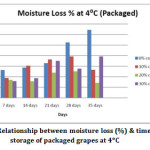 |
Figure 1: Relationship between moisture loss (%) & time of storage of unpackaged grapes at 4ᵒC |
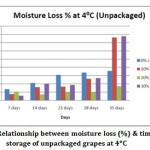 |
Figure 2: Relationship between moisture loss (%) & time of storage of packaged grapes at 30ᵒC |
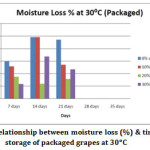 |
Figure 3: Relationship between moisture loss (%) & time of storage of unpackaged grapes at 30ᵒC |
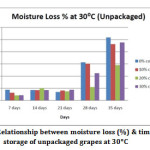 |
Figure 4: Relationship between pH and time of storage of packaged grapes at 4ᵒC |
Grapes pH
The pH of the grape juice was found to be gradually increasing during the course of storage as shown in graphs. The groups with packaging’s and which were stored in 30⁰C in incubator showed acidic behavior from 14th day to 21st day. This was due to the browning, decaying and microbial attack on the grapes due to packaging and due to high temperature. The final value of pH for uncoated grapes in 30⁰ C and unpackaged condition was 6.96. this was due to the fact that they lost all their moisture in the total storage time. Packaged grapes with storage in 4⁰C gave the minimum pH. The pH of all the coating concentration did not gave very much difference except the 20% coating. There was no significant difference between the two treatments (10.0% and 30.0%). It was found that coated grapes had higher value at the end of storage period; this was due to the semi-permeability created by aloe vera coatings on the surface of the fruit, which might have modified the internal atmosphere i.e. endogenous O2 and CO2 concentrations in the fruit, thus retarding ripening.
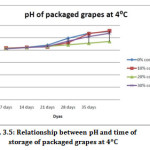 |
Figure 5: Relationship between pH and time of storage of unpackaged grapes at 4ᵒC |
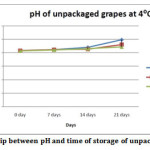 |
Figure 6: Relationship between pH and time of storage of unpackaged grapes at 30ᵒC |
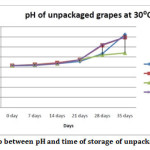 |
Figure 7: Relationship between pH and time of storage of packaged grapes at 30ᵒC |
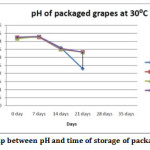 |
Figure 8: Relationship between pH and time of storage of packaged grapes at 30ᵒC |
Conclusions
Grapes were coated with Aloe veragel suspended in water with concentrations 0, 10, 20 and 30 per cent and were stored in poly packaging and open plates under different temperatures of 0⁰C and 30⁰C in refrigerator and incubator. Initially the weights of grapes were taken and made 16 groups of 100 ±1gm. Grapes were stored for a period of 35 days and the readings were taken accordingly. Fruit gloss, decaying, rachis browning, weight loss and pH were evaluated during the storage period.
Coating concentrations, temperature and packaging had an effect on weight loss, fruit gloss, colour and pH. The weight losses of coated grapes have decreased with increasing concentrations of coating. 30% coating concentration gave more weight loss on the contrary. 20% coating concentration gave the least moisture loss on all the parameters taken. Weight loss over time was due to loss of moisture content of the grapes. The coating made a barrier in the surface and less moisture was lost in the coated grapes. A lack of coating integrity and uniformity may have allowed moisture to escape from the grapes. Normally grapes turn brown over time due to rachis browning and enzymatic changes and loss of water. Edible coating was hypothesized to help maintain firmness by sealing in moisture. The higher coating concentration of 20% makes these coatings more appropriate for extension of shelf life.
In the storage poly packaging and open plates were used to store the sample under different temperatures. The poly packaging made grapes brown, acidic and microbial activity increased in incubator at 30⁰C so it was concluded that poly packaging can increase shelf life by 1-2 weeks under 30⁰C storage conditions and upto 2-3 weeks at same temperature under open conditions. The poly packed grapes which were stored in refrigerator at 4⁰C gave increase in shelf life for 35 days and those in open plates under refrigerator gave 3-4 weeks shelf life.
References
- Aburjai, T.; Natsheh, F.M 2003. Plants used in cosmetics. Phytother. Res. 17, 987- 1000.
CrossRef - Adetunji, C.O 2008. The antibacterial activities and preliminary phytochemical screening of vernoniaamygdalina and Aloe vera against some selected bacteria. M.sc Thesis University of Ilorin. Pp.40-43.
- Alleynev, V., Hagenmaier, R. (2000).Candelilla Shellacan alternative formulation of apples. Hortcoating Science-35(4) 691-693,14.
- Amarantee, C., Banks, N.H 2001. Post-harvest physiology and quality of coated fruits and vegetables. Hort. Rev. 26, 161-238.
- Anonymous. September (2003). Agribusiness Report. Agri business information centre, Ficci Publications.
- Anonymous. (1990).Sleeping Beauties. Nutrition and Food Science. No. 127, 12-13.
- Atterholt, C. A., M. J. Delwiche, R. E. Rice and J. M. Krochta. (1998). Study of biopolymers and paraffin as potential controlled-release carriers for insect pheromones J Agriculture Food Chemistry. 46:4429-4434.
CrossRef - Avena-Bustillos, RJ., and J.M. Krochta. (1993). Water vapor permeability of caseinate-based Edible films as affected by pH, calcium cross linking and lipid content Journal of Food Science 584:904-907.
CrossRef - Avena-Bustillos, R., Krochta, J.M., Saltveit, M.E., RojasVillegas, R., and Sauceda-
CrossRef - Perez, JA. (1994). Optimization of Edible coating formulations on zucchini to reduce water loss. Journal of Food Engineering. 21:197-214.
- AvenaBustillos, R. J.,LA. Cisneros zevallos, J. M. Krochta, and M. E. Saltveit. (1994). Application of casein-lipidEdible film emulsions to reduce white blush on minimally processed carrots. Post-harvest Biol. and Tech. 4(1994): 319-329.
CrossRef - AvenaBustillos, R., J. M. Krochta and M. E. Saltveit. (1997). Water vapor resistance of red delicious apples and celery sticks coated with Edible caseinate-acetylated monoglyceride films. J Food Science. 62(2):351-354.
CrossRef - Babu KH.,Zeeruddin M and Prasad P.K.(1990).Studies post-harvest storage of on custard apple.ActaHorticultura .No.269-299.
- Baldwin, E.A.(1991). Edible coatings for fresh fruits and vegetables: past, present, and future. Edible Coatings and Films to Improve Food Quality. pp 25-64
- Bangerth, F. (1977). The effect of different partial pressures of ethylene and oxygen in the storage atmosphere on theascorbic acid content of fruits and vegetables. QualitasPlantarum 27:125-133.
- Balagtas, J. V. F. M. Hutchinson, J. M. Krochta and D.A.Sumner, (2003). Anticipating market effect of new uses for whey and evaluating returns to research and development. J Dairy Science. 86: JDS2534.
CrossRef - Bangerth, F. (1977). The effect of different partial pressures of ethylene and oxygen in the storage atmosphere on the ascorbic acid content of fruits and vegetables. QualitasPlantarum 27:125-133.
- Ben Yehoshua, S. (1987). Transpiration. water stress, and gas exchange.Post harvest Physiology of Vegetables. pp113-170.
- Burg, SP. and Burg EA. (1965). Ethylene action and the ripening of fruits. Science 148:1190-1196.}
CrossRef - Burton, W.G. (1982). Ripening and senescence of fruits. Post-harvest Physiology of Food Crops. pp 181-198.
- Burton, W.G. (1982).Post harvest change and the loss of nutritive value. Post-harvest Physiology of Food Crops. pp 127-146.
- Cisneros Zevallos, L and J. M. Krochta. (2003). Dependence of coating thickness on viscosity of coating solution applied to fruits and vegetables by dipping method Food Science 68(2): 503-510.
CrossRef - Crisosto CH, Smilanick JL, Dokoozlian NK, Luvisi DA (1994). Maintaining table grape post-harvest quality for long distant markets. Proceedings of the International Symposium on Table Grape Production, American Society for Enology and Viticulture, pp. 195–199.
- DavoodBakhshi, Mohammad Ali Shiri , Mahmood Ghasemnezhad , Monad Dadi, Alexandros Papachatzis , Helen Kalorizou 2013. Chitosan coating improves the shelf life and postharvest quality of table grape Vitisviniferacultivar Shahroudi. Turkish Journal ofAgriculture and Forestry 37: 148-156.
- Debeaufort, F. Quezada-Gallo, J.A. and Voilley, A. 1998. Edible films and coatings: tommorrow s packaging: a review. Crit. Rev. Food Sci. 38, 299-313.
CrossRef - Dziezak, J.D. (1991). Special Report: A focus on gums. Food Technolog 45(3):116-132.
- Eaks, I.L (1956). Effect of modified atmosphere on cucumbers at chilling and non-chilling temperatures. Proceedings of the American Society for Horticultural Science 67:473-478.
- Elsion CM and Hayes E.R. (1985). Development of the differentially permeable fruit coating Nutri Save for the modified storage of fruit. Controlled atmosphere for the storage and transport of perishable agriculturist products. 4th national controlled atmosphere conferenceheld at CaliforniaJuly 1985, 248-262;1.
- Eshun, K. and He, Q. 2004. Aloe Vera: a valuable ingredient for the food, pharmaceutical and cosmetic industries: a review. Crit.Rev. Food. Sci. Nutr. 44, 91-96.
CrossRef - Gennadios, A., McHugh T.H., Weller C., and Krochta, J.M. (1991). Edible coatings and films based on proteins. Edible Coatings and Films to Improve Food Quality. pp 201-277
- Ghaouth, A.E., Arul, J., Ponnampalam, R, Boulet, M. (1991). Use of chitosan coating to reduce weight loss and maintain quality of cucumber and bell pepper fruits. Journal of Food Processing and Preservation 15:359-368.
CrossRef - Gregory, J.F. (1996). Enzymes. Food Chemistry. (3rd ed.).pp 431 -530.
- Greulach, VA. (1973). Respiration. Plant Function and structure. pp 94-113.
- Greulach, V.A. (1973). Auxins and Ethylene. Plant Function and Structure. pp 325-354.
- Gupta S.Kand Gupta G.K(1992). Role of preharvest fungi cudal sprays and postharvest wax catings against sooty blotch, fly speck and storage rot of apples Plant Disease Research. 7:22,161-164:5.
- Habeebunnisa, M. Pushpa, Candsrivastava, H.C. 1963. Studies on the effect of the protective coatings on the refrigerated and common storage of bell peppers. Food Science 192-196.
- Hardenburg, RE. (1967) Wax and related coatings for horticulture products. A bibliography. Agricultural Research Service Bulletin 51-15.
- Hernandez, E. (1991) Edible coatings from lipids and reins. Edible Coatings and Films to improve Food Quality. pp 279-303.
- Hagenmaier, R.D. and Baker, R.A. 1995. Layers of coatings to control weight loss and preserve gloss of citrus fruit. Hortscience 30, 296-298.
- IS :6271, 1971. Food grains moisture content for safe storage. Part 2. New Delhi.
- Ishikawa M. and Nara H.L. (1991) Inhibition of solute permeationin osmotic dehydrationof food by chitosan membrane coatin. Bulletin of Japanese society of seientificfisheries.57(4) 767.6.
- Jasso de Rodiguez, D.J Hernandez-castillo, D.J., Rodriguez Garcia, R., Angulosanchez. J.L. 2005. Antifungal activity in vitro of Aloe Vera pulp and liquid fraction against plant pathogenic fungi ind. Crop prod., 21, 81-87.
- Jeong J., Huber, D.J and Sargent, S.A., 2003. Delay of avocado Persea Americana. Fruit ripening by 1-methyl cyclopentane and wax treatments, post-harvest Biol. Techno. 28, 247-257.
- Kader. AA. (1983).Post harvest quality maintenance of fruits and vegetables in developing countries. Post-harvest Physiology and Crop Preservation. pp 455-470.
- Kader, AA. (1987). Respiration and gas exchange of vegetables. Post-harvest Physiology of Vegetables. pp 25-43.
- Kaplan, HJ. (1986) Washing, waxing, and color adding. In: Fresh Citrus Fruits. Pp 379.395
CrossRef - Kester. JJ. andFennema, O.R. (1986). Edible films and coatings: a review. Food Technology 12:47-59
- Kester, JJ. andFennema, O.R. (1989). An Edible film of lipids and cellulose ethers: barrier properies to moisture vapor transmission and structural evaluation. Journal of Food Science 540:1383-1389.
CrossRef - Kolattukudy, PE (1980).Biopolyester membranes of plants: cutin and suberin. Science 208.990- 1000.
CrossRef - J. J. M. Krochta, M. E. Saltveit. R. J. and J. A. Sauceda-Perez (1994). Optimization of Edible coating formulations on zucchini to reduce water Loss. J. Food Engineering. 21:197-214
CrossRef - Lauchli, A. (1976). Apoplasmie transport in tissues. In: Transport in Plants ll. Part B Tissues and organa. Encyclopedia of Plant Physiology 31-34.
- Martinez-Romero D, Guillén F, Valverde JM, Bailén G, Zapata PJ, Serrano M, Castillo S, Valero D, 2007. Influence of carvacrol on survival of Botrytis cinerea inoculated in table grapes. International Journal Food Microbial. 115: 144 148.
CrossRef - Ni, Y., Turner, D.; Yates, K. M.; Tizard, I. 2004. Isolation characterization of structural components of Aloe veraL. leaf pulp Int. Immunopharmacol. 4, 1745-1755.
CrossRef - Ozdemir AE, Candır EE, Kaplankıran M, Soylu EM, Şahinler N, Gul A (2010). The effects of ethanol-dissolved propolis on the storage of grapefruit cv. Star Ruby. Turk J Agric For 34: 155–162.
- Phan, C.T. (1987).Biochemical and biophysical changes during the harvest period.Post-harvest Physiology of Vegetables.pp 9-22.
- Phan, CT., Pantastico, ER B., ogata, K and Chachin, K (1975).Respiration andrespiratoryclimateric.PostHarvest Handling and Utilization of Tropical andSubtropical Fruits and Vegetables. (3rd ed.). pp 86-102.
- Pratt, H.K. and Goeschl, J.D. (1969).Physiological roles of ethylene in plants. AnnualReviews Plant Physiology 20:541-584.
CrossRef - Quezada-Gallo, Debeaufort, F., J.A., Voilley, A., 1998. Edible films and coatings tomorrow’s packaging: a review. Critical Reviews in Food Science & Nutrition 38, 299–313.
CrossRef - Reid, Ms. (1985).Ethylene and abscission.Hortsclence 20(1): 45-50.
- Rahman, A.A., Huber, D.J., and Brecht, J.R. 1993. Respiratory activity andmitochondrial oxidative capacity of bell pepper fruit following storage under lowoxygen atmosphere. J. Amer. Soc. Hort. Sci. 118(4): 470-475.
- Reynolds, T. and Dwee, A.C. 1992. Aloe vera leaf gel: a review update. J. Ethnopharmacol. 68, 3-37.
CrossRef - Risse L.A., and Hatton, TT. (1982). Sensitivity to watermelons in Hortscencestorage. 17(6): 946-948.
- Saks, Y and Barkai-Golan, R 1995. Aloe vera gel activity against plant pathogenic fungi, post harvest Biol. Technol 6: 159-165.
- Salunkhe, D.K., Bolin, H.R., and Reddy, NR.(1991). Storage Methods.Storage,processing and nutritional quality of fruits and vegetables.Vol I. (2nd ed) pp 243-294.
- Saltveit, M.E.(1977).Carbon dioxide, ethylene and color development in ripeningmature green peppers. Journal of the American Society for Horticultural Seience102(5):523-525.
- Sanderson, G.R. (1981), Polysaccharides in foods, Food Technology 35(7):50.57,83.Sarkar, S.K. and Phan, CT. 1979. Naturally-occurring and ethylene-induced phenolic compounds in the carrot root. Journal of Food Protection42(6):526-534.
CrossRef - Sastry, s.K., Baird, C.D., and Buffington, D.E. (1978). Transpiration rates of certainfruits and vegetables. ASHRAE Transactions 80(84):237-255.
- Sebti Land Coma V.(2002).Active edible de coating and interactionsbetween solution coating compounds. Carbohydrate 49(2) 139-14420.
CrossRef - Shaw, PE. 1991. Fruits I.Volatile Compounds in Foods and Beverages. 305-327.
- Singh R.(1973). Effect of wrappers and wax coating on the apples storage life at roomtemperature in Lahul Valley. Plant Science, 5:152-154:9.
- Smith, S., Geeson, J. and Stow, J. (1987).Production of modified atmospheres indeciduous fruits by the use of films and coatings.Horscience 22(5):772-776.
- Smock, R.M. (1935).Certain effects of wax treatment on various varieties of apples andpears. Proceedings of the American Society for Horticultural Science 33:284-289.
- Starr, C. and Taggart, R. (1989). Water, solutes, and plant functioning. Biology: TheUnity and Diversity of Life. (5th ed.). pp 267-277.
- Surjushe A, Vasani R, Saple DG. Aloe vera: a short review. Indian J Dermatol. 2008; 534:163-6.
CrossRef - Thanaboripat D. Control of Aflatoxins in Agricultural Products using plant extracts. KMITL Sci. Tech. J. 2008; 11:1-35.
- Trout, S.A., Hall, E.G., Robertson, RN., Hackney, FM.V. and Sykes, s.M.(1942).Studies in the metabolism of apples. I. Preliminary investigations on internal gascomposition and its relation tochanges in stored granny smith apples. Aust J Exp.Biol Med Sci. 20:219-231.
CrossRef - Van Buren, J.P. (1979).The chemistry of texture in fruits and vegetables. Journal of Texture Studies 10:1-23.
CrossRef - Van den Berg, L. 1987. Water vapor pressure.Post harvest Physiology of Vegetables. Pp203-230.
- Valuerde J.M., Valero A, Martinez-Romero D, Guileen F. and Castillo S. 2005. Novel edible coating based on Aloe veragel to maintain table grape quality and safety, J. Agric. Food Chem 53, 7807-7813.
CrossRef - Vial P, Crisosto C, Crisosto G (2005). Early harvest delays berry skin browning of ‘Princess’ table grapes. California Agric 59: 103–108.
CrossRef - Von Elbe, J.Hand Schwartz s.J.(1996.) Colorants.Food Chemistry.651-722.
- Wang, C.Y.(1977).Effect of co treatment on storage and shelf life of sweet peppers.Journal American Society of Horticultural Science. 1020:808-812.
- Wang, C.Y. (1982). Physiological and biochemical responses of plants to chillingstress.HortScience 17(2):173-186.
- Wanstedt, K.G., Seideman, S.C., Donnelly, LS.andQuenzer, N.M. (1981). Sensoryattributes of precooked, calcium alginate-coated pork patties. Journal of FoodProtection 44(10):732-735.
CrossRef - Watada, A.E. (1987).Vitamins.Post harvest physiology of vegetables. pp 455-468.
- Whitaker, J.R. (1996).Enzymes.Food Chemistry. (3rd ed.). pp 431-530.
- Wimalasiri, P. and Wills, R.B.H. (1983).Simultaneous analysis of ascorbic acidanddehydroascorbic id in fruits and vegetables by high-performance liquidchromatography. Journal of Chromatography:368-371.
CrossRef - Wolf, I.A.,DavisH.A.Cluskey, J.E, Gundrum, L. J.,andRist, CF.(1951). Preparation of films from amylose. Industrial and Engineering Chemistry43:915-919.
CrossRef - Wong, D. ws.,Tillin, s.J., Hudson, J.S., and Pavlath, A.E. (1994).Gas exchange incut apples with bilayer coatings. Journal of Agriculture and Food Chemistry42:2278-2285.
CrossRef

This work is licensed under a Creative Commons Attribution 4.0 International License.





